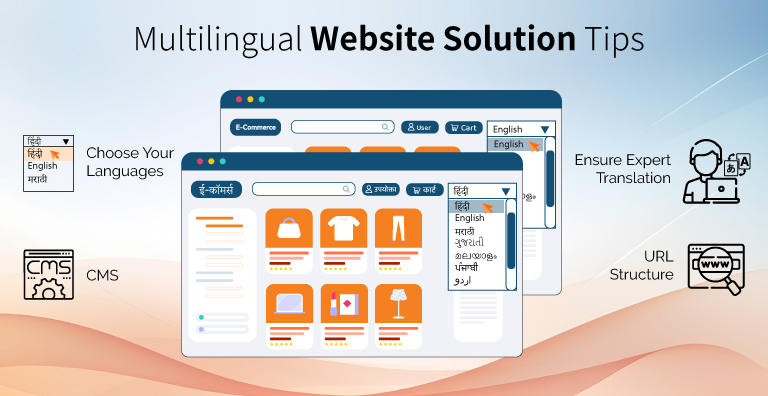Gone are the days when websites were treated as information platforms. Today, they’ve become virtual experience centers. The better your website’s experience, the more it engages, simple! An essential part of the experience aspect is user-website interactions. Traditionally, English has been the de-facto language of websites. But with regional language internet users on the rise, people now expect websites to interact with them in their language. That’s where the need for a multilingual website and multilingual website solution step in!
While it is a prudent decision to employ a multi-language website solution, knowing a few essential aspects can help you make the most of it. So, if you’ve been planning to go multilingual with a multilingual website solution, here are some tips and best practices to help you optimize your project’s value.
11 Multilingual Website Solution Best Practices
Here’s how you can plan to go multilingual with a multilingual website solution.
1. Choose Your Languages
As a business, while going multilingual you would already know the regions you intend to target. Accordingly, identify the languages of the target regions and those you want your website to support. It will help you streamline your focus and work only on what you need.
2. Choosing a Content Management System (CMS)
Linguify supports all CMSs, offering a versatile solution for translating your website content, ensuring that your site can effectively reach and engage with users in multiple languages.
3. Ensure Expert Translation
Work with a professional translation company that serves all the languages you intend to target and have a comprehensive understanding of your subject matter. Ensure your translated content is culturally appropriate and resonates with the tone and style of the original text.
Additionally, stay sensitive and careful about cultural differences while designing the website. Pay attention to elements like symbols, colors, imagery and content. Avoid using language, complicated statements, idioms, slang, etc., to avoid misunderstanding and its repercussions.
4. Have a Clear URL Structure
In addition to the above, ensure you use a clear and SEO-friendly URL structure for each language version of your website. You may use subdirectories like .com/en, .com/fr, etc., for different language versions to make the URLs recognizable.
5. Give SEO the Attention it Deserves
One of the purposes of going multilingual is to increase visibility across regional language searches. Besides, the fact that search engines drive a significant amount of traffic to your websites makes SEO an imperative aspect to consider. Accordingly, optimize each language version of your website for search engines with keywords, meta tags, and Hreflang attributes. Additionally, create different sitemaps for all the language versions and submit them to search engines.
6. Use a Language Switcher
Users should be able to switch between languages seamlessly and in as few clicks as possible. Thus, consider including a prominent and intuitive language switcher on your website to enable easy switching between language versions. Position the language switcher in a consistent location across all your web pages. For instance, you can place it on the header or footer.
7. Create a Responsive Design
These days, most users use mobile phones to access websites. Hence, never ignore or forget to make the multilingual version of your website mobile-responsive. Every multilingual feature you provide on the desktop version of the website should be available on the mobile version for effortless navigation and a memorable multilingual interaction experience.
8. Ensure Consistent Branding
Maintain uniformity of branding across all the versions of your language. It includes ensuring uniformity across colors, fonts, logos, etc. so that the multilingual web pages don’t look disconnected or different from the original version of the website.
9. Compliance
Another of the significant aspects of multilingual website solution tips is ensuring the multilingual website complies with the necessary legal and regulatory requirements of every target market. Accordingly, you should include privacy policies, terms of service, and other legal documents in all the target languages.
10. Test Thoroughly
Test your website thoroughly for every language. The testing process should include examining the website for linguistic accuracy, functionality, usability, user experience consistency, formatting, layout alignments, and more. Partnering with a website localization service provider can help you manage these aspects comprehensively and present a thoroughly tested website to your users.
11. Ensure Regular Updates and Support
Ensure regular updates to the content across all the versions to maintain content consistency and relevance. The multilingual website solution you use should be able to support website change management and updates efficiently to maintain the competence of your website. You can also monitor user feedback and leverage analytics to identify pain points or areas requiring optimization.
Partner with Linguasol for a Complete Multilingual Solution for your Website!
Amplify the user experience and support of your multilingual website with Linguify multilingual solutions for websites. Our comprehensive support involves everything from translation to localization, change management, and ensuring website competence at all times. Email us at sales@linguasol.net to explore more about our multilingual website solution.
Ref. No- LSB6241047

